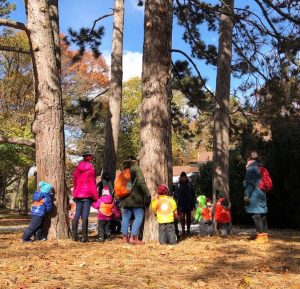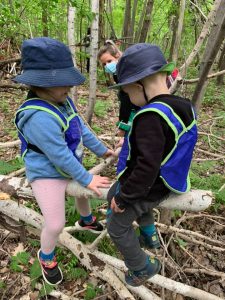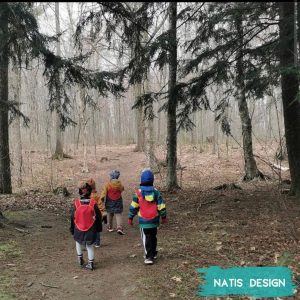By Nathalie Lizé
Early Childhood Educator
Early Years Education through nature (Forest School, nature school, outdoor preschool), is it something you are familiar with? This emerging approach has been developing strongly in classrooms and daycare settings in Quebec (Canada) and in the rest of North America recently. It is more common in Europe and in several countries around the world. Before doing an overview of this educational model, I think it would be interesting to know about its origin.

Photo credit: https://www.atelierkids.com/
First in Denmark
It originates from the Scandinavian countries, more precisely from Denmark. This teaching philosophy was imagined by Ella Flateau in the 1950s. Confronted with schools full to capacity, she innovated by proposing to move the classes outside to benefit from more space. This is how the Forest Schools were born. The foundations of this approach were first thought out by the German educator Friedrich Fröbel. which opened the first kindergartens in Germany in 1830. Its primary goal was to enable children from underprivileged families, of preschool age, to attend a daycare environment. Thus, workers could go to work and their progeny will be able to leave their family environment and live new experiences. You can learn more about him and his pedagogy by consulting this link.
https://en.m.wikipedia.org/wiki/Friedrich_Fr%C3%B6bel
Learning outside
The predominance of natural materials and outside learning characterizes this particular educational method. All the development spheres are exploited in their entirety (physical and motor, cognitive, emotional, social and language), children learn by exploring their environment, develop their autonomy, their ability to adapt and their relationship with peers in free play and fun. Their classroom have no walls and their discoveries have no limits. Children rediscover the power to play without excessive constraints, outdoors. In addition to seeing their need to move and explore fulfilled, they develop environmental respect. What better way to learn to take care of nature than to be in contact with it on a daily basis? Furthermore, frequent exposure to the outdoors promotes calm and naturally leads to slow down living. It is less noizy and the playing areas are more spacious. The sense of calm and the atmosphere of tranquility that reigns in the forest or other green spaces promotes better mental and physical health. Everyone’s rythm is easier to respect since the schedule is less restrictive. Spending time outdoors promotes a better ability to concentrate, therefore, helps children with attention déficit disorder and hyperactivity. For those struggling with anxiety and difficulty managing stress, as well as children with autism spectrum disorder, this pedagogy has definite benefits too. The special physical movements that are done outdoors on bumpy, rocky, sandy, muddy soils and where kids climb and run stimulate gross motor skills. The immune system is also strengthened. From a physical and mental point of view, the benefits are indisputable.
Being outdoors
The watchword is to be outdoors as often as possible and for as long as possible, toi do the daily activities rain or shine, in mild and cold weather. To offer the playground and let the children do the rest. To make the most of it, you have to wear suitable clothes, adapt your routines to your environment and to each of your little ones. It’s so nice to play in the mud, to jump in water, or to Play in the snow. The morning welcome, lunch, nap, playing moments and even the end of the day are experienced in the great outdoors. We let the children climb, run, and jump. They are allowed to take calculated risks while keeping safety in mind. For example, we know that climbing a tree increases self-confidence, autonomy and resourcefulness. So, we are with the child, but we let him experience it. This reality requires that the partnership with parents, which must always exist in childcare, be put forward. It becomes a major issue. They must understand the reality of this exposure to certain risks and adhere to this philosophy. Because, all these extraordinary moments which cannot be lived between 4 walls also allow them to tame the limits of their body and to push them further. Friends help each other by looking for solutions together, which strengthen bonds and improve socialization. Symbolic play using objects found in a natural environment is also stimulated. A bundle of small branches becomes a campfire, an ant house or even a beaver dam. You can count them, classify them by size or even paint them. Contact with insects, small animals or birds sensibilise to the living world and children understand that it is important to take care of it. The possibilities are endless, but above all the activities must come from free games and children and take place outdoors and with natural materials. The language is stimulated by new words, a diverse and more elaborate vocabulary. Since there is less noise, some children who are quieter in noisy environments are likely to speak more.

like our pinnies on the image above? more about our daycare pinnies
Not only in forests
It is mistakenly believed that it is not possible to work with this educational philosophy in an urban environment. It requires greater adaptability and more creativity, but it can still be done. You have to adapt the courtyard, create spaces that bring nature to the city; plant trees to climb on, put sand, flowers, grass, do gardening projects, create sensory boxes from natural textures with; pine cones, pebbles, shells, branches, straw, etc… Be inventive and change them according to the seasons.
There are some interesting examples for autumn and the forest found on pinterest
https://pin.it/2DWjIX0
https://pin.it/4TKickZ
Look for green spaces near your surroundings and return regularly. Go on an insect hunt, observe the animals and above all, let the children use their potential and their creativity to make their own discoveries and experience role-playing games related to what they see. The child is the primary agent of its development. Your role is to follow him and guide everything so that he goes further. Don’t hesitate to go out and play in the water holes when it rains. Your little ones will realize that the sounds of the city are different on rainy days. Of course, a park can not be compared to a forest but it is still possible to live enriching experiences there. If you find the change too drastic, take it a step at a time. Start in summer, on sunny days. Go out in the morning and at the end of the day. Add snack time ans lunch time. Try a nap every now and then and increase the challenge. Use your creativity, let your imagination run wild, respect everyone’s uniqueness, but above all, have fun with your little ones because to learn, they need to play.
To familiarize yourself more with education through nature, I strongly suggest that you check out this link from Forest School Canada
FSC-Guide-1.pdf (childnature.ca)
Talk to you soon
Nathalie Lizé
Preschool educator and family coach



